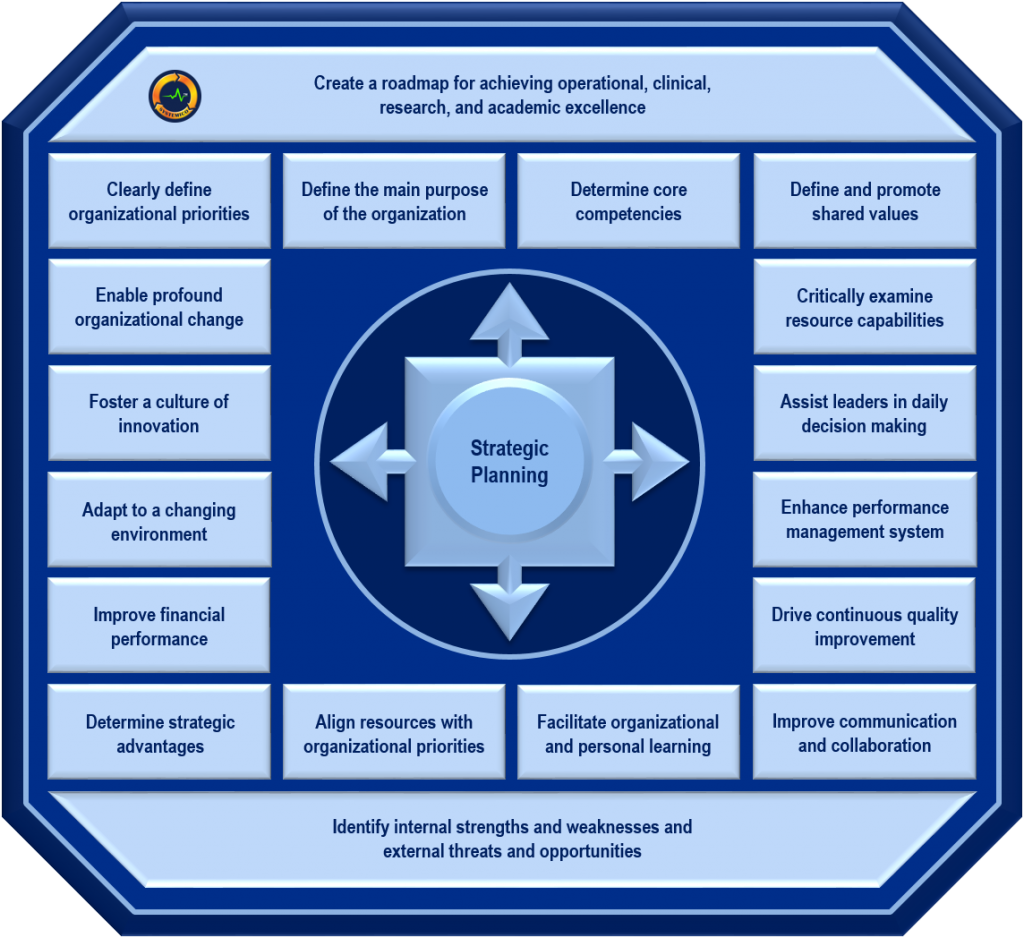Strategic planning represents a systematic, flexible and continuous process to define or reaffirm the main purpose of an organization, visualize the future in the context of internal and external business environment, establish clear strategic directions, build organizational commitment, and formulate strategies to overcome challenges and maximize future opportunities. Strategic planning is one of the key management tools used to sharpen organizational focus, improve overall performance and ensure long-term sustainability. Strategic planning alone cannot produce results; however, a properly planned and executed strategic planning process brings a number of benefits to the organization, patients and our community at large.

Clarity of strategic directions achieved through the strategic planning process is essential particularly when various improvement and innovation initiatives may compete for limited organizational resources. Strategic planning can be successfully done at many different levels of the organization; it may be limited to one division, department, unit, specific function, or it could involve multiple departments or the entire organization. Although strategic planning at any level of the organization may be perceived as a daunting undertaking, effective strategic planning enables organizational leaders to create a unified, integrated and comprehensive blueprint for action in pursuit of operational, clinical, research, and academic excellence. Setting and implementing multiple strategic goals and objectives within an inherently complex and uncertain system requires consistency, cross-functional integration of action plans, alignment, and seamless coordination among departments, teams and other stakeholders within and outside the organization. The strategic planning process and resulting decisions have significant ramifications, not only for the future of the organization, but also have an immediate impact on day-to-day operations. When achievement of the strategic goals requires a large-scale organizational change strategic planning must rely on visionary leaders who fully understand the change process in a complex organization. Effective leaders have to focus on achieving results, convey a sense of urgency, remove obstacles, visibly demonstrate commitment to their employees, foster open communication, and persistently reinforce the shared vision, mission and core values by their actions. At the same time, organizational structures, systems and processes to support change efforts must be carefully designed and implemented.
While many healthcare organizations are increasingly capable of carrying out various strategic planning exercises, effective implementation and monitoring of strategic and tactical action plans is still a major challenge. Many people have memories of long meetings and tedious planning processes that produced a beautiful plan that was never fully implemented. A healthcare organization will be able to create a shared framework for the future and achieve desired results by avoiding the following pitfalls that are commonly associated with the strategic planning process:
- Failure to involve key stakeholders in the planning process
- Setting unrealistic expectations
- Failure to articulate assumptions and constraints
- Lack of resources and time for planning
- Strategic planning considered to be a one-time event, rather than a process
- Disagreement on priorities and strategic planning outcomes
- Leadership indifference or destructive interpersonal conflicts
- Failure to address resistance to change
- Excessive focus on current operational issues
- Roles and responsibilities not clearly defined
- Relying on inadequate or inaccurate information
- Ineffective communication
- Lack of ownership and accountability for results
- Strategic planning becomes a substitute for leadership
- Unwillingness or inability to respond to the changes in business environment
- Creating overwhelming, inflexible and complicated documents
- Lack of systematic processes for monitoring and control
- Incentives and rewards not aligned with strategic goals
- Lack of authority and resources for implementation
- Establishing and pursuing too many strategic goals
- Lack of contingency planning
- Organizational culture that does not inspire innovation and strategic thinking
- Lack of integration with the overall management processes


